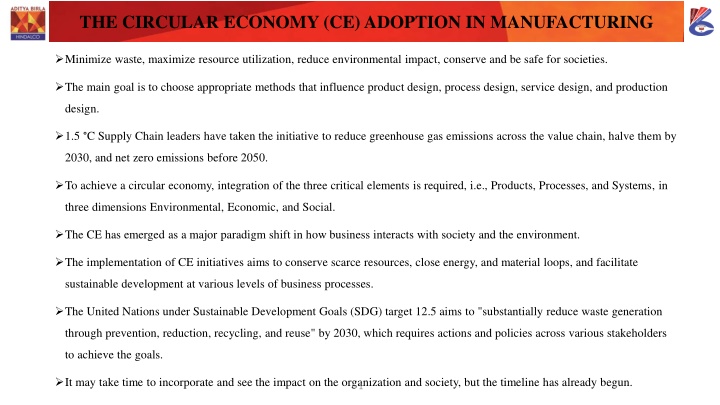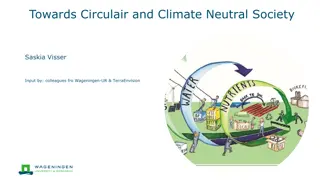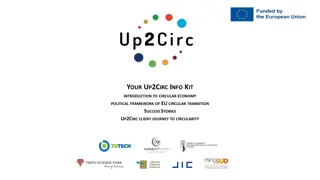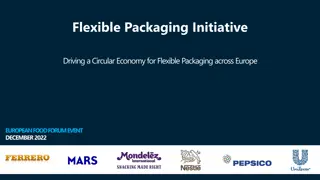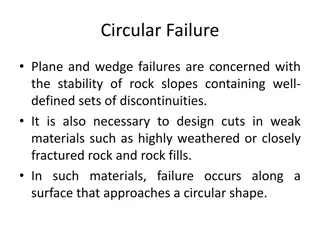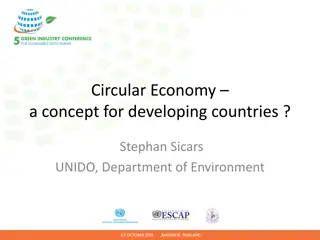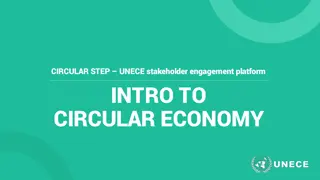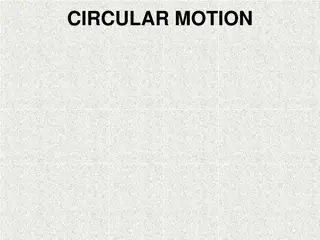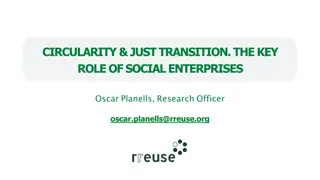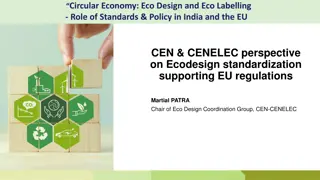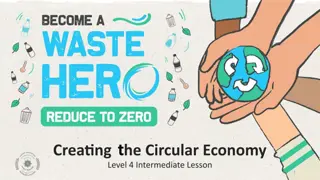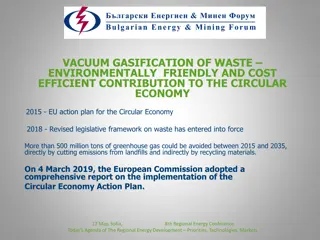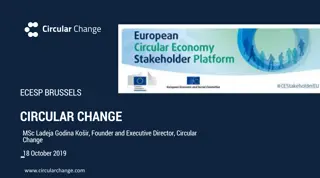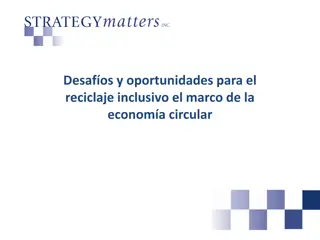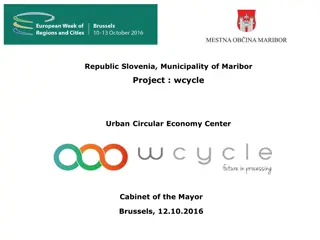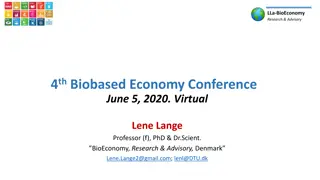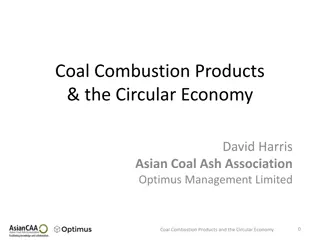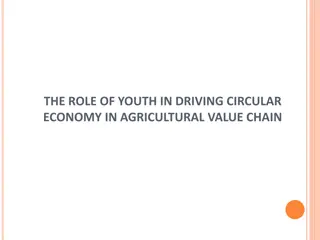Circular Economy Adoption in Manufacturing: Driving Sustainable Innovation
The circular economy (CE) adoption in manufacturing focuses on minimizing waste, maximizing resource utilization, and reducing environmental impact. Supply chain leaders are taking initiatives to reduce greenhouse gas emissions and achieve net zero emissions by 2050. However, challenges lie in reconciling economic imperatives with ecological sustainability to transition from linear to circular business models. The CE plays a crucial role in creating shared value and promoting inclusive and sustainable development.
Download Presentation

Please find below an Image/Link to download the presentation.
The content on the website is provided AS IS for your information and personal use only. It may not be sold, licensed, or shared on other websites without obtaining consent from the author.If you encounter any issues during the download, it is possible that the publisher has removed the file from their server.
You are allowed to download the files provided on this website for personal or commercial use, subject to the condition that they are used lawfully. All files are the property of their respective owners.
The content on the website is provided AS IS for your information and personal use only. It may not be sold, licensed, or shared on other websites without obtaining consent from the author.
E N D
Presentation Transcript
THE CIRCULAR ECONOMY (CE) ADOPTION IN MANUFACTURING Minimize waste, maximize resource utilization, reduce environmental impact, conserve and be safe for societies. The main goal is to choose appropriate methods that influence product design, process design, service design, and production design. 1.5 C Supply Chain leaders have taken the initiative to reduce greenhouse gas emissions across the value chain, halve them by 2030, and net zero emissions before 2050. To achieve a circular economy, integration of the three critical elements is required, i.e., Products, Processes, and Systems, in three dimensions Environmental, Economic, and Social. The CE has emerged as a major paradigm shift in how business interacts with society and the environment. The implementation of CE initiatives aims to conserve scarce resources, close energy, and material loops, and facilitate sustainable development at various levels of business processes. The United Nations under Sustainable Development Goals (SDG) target 12.5 aims to "substantially reduce waste generation through prevention, reduction, recycling, and reuse" by 2030, which requires actions and policies across various stakeholders to achieve the goals. It may take time to incorporate and see the impact on the organization and society, but the timeline has already begun. 1
WASTE REDUCING, REUSING, AND RECYCLING (3R) : WASTE HIERARCHY 2
CHALLENGES FOR THE CIRCULAR ECONOMY IN MANUFACTURING The CE has become more significant for manufacturing because customers, governments, and investors demand more sustainable products in the coming future. The CE is the new way of creating shared value and promoting inclusive & sustainable development. In recent times, environmental pressures are necessitating concerns for business sustainability through technological innovation intending to improve the design, implementation, and evaluation of sustainable policies. In such a scenario, a significant challenge confronting businesses is reconciling economic imperatives with ecological sustainability. Many firms attempt to apply circular economy principles to their business practices to achieve positive economic, environmental, and social benefits. However, these firms often struggle to change their existing linear business models to circular models because the steps required for successful transformation are still poorly understood. The attainment of the circular model requires cyclical and regenerative environmental innovation at all levels of the business value chain. Considering the alarming level of concerns related to resource degradation and business sustainability, it is critical to creating a global platform to discuss the emerging issues in implementing the circular economy at the micro and macro levels. 3
CHALLENGES FOR THE CIRCULAR ECONOMY IN MANUFACTURING "Climate change is destroying our path to sustainability. Ours is a world of looming challenges and increasingly limited resources. Sustainable development offers the best chance to adjust our course." - Ban Ki-moon, Secretary-General of the United Nations. India is the second-most populous country globally, with more than 1.35 billion residents reported in 2020. It is also the fastest-growing major economy in the last decade with an annual average gross domestic product (GDP) growth rate of 6-8% and contributed $3.05 trillion to the world s total GDP in 2021. Although, the COVID-19 pandemic has significantly affected the economy and human lives, reduced the GDP to -7.3 in 2020 and it is projected to be 9.5% and 8.5% in 2021 and 2022, respectively. However, India s global GDP and international trade contributions are moderately low, contrary to its population and size. Further, the country lacks numerous societal, economic, and environmental issues compared to the developed world. The manufacturing sector is one of the quintessential components to balance employment generation, economic growth, and environmental sustainability. Due to that, it is admitted as the backbone of the country s economy as it offers a significant contribution to GDP and job creation. (Figure 1) MSMEs are the key players in the manufacturing domain because of their plentiful production output, export, and employment generation. However, in India, MSMEs are not well equipped with emerging technologies, and they do not follow up quality and environmental standards. Figure 1: Products, Processes, and Systems, in three dimensions of Environmental, Economic, and Social. 4
CHALLENGES FOR THE CIRCULAR ECONOMY ENVIRONMENTAL POLICIES AND STANDARDS Environmental degradation has been identified as a vital concern by world-level organizations like the United Nations, International Finance Corporation, and several countries' governments. Various environmental policies have been described to defeat air pollution, water pollution, waste management, soil contamination, and climate shifts that also need to be considered by manufacturing enterprises. In support of these policies, a few international standards have also been established by the International Organization for Standardization (ISO) regarding manufacturing, for example, ISO 14000 series. In India, the Environmental Protection Act, 1986, Water (Prevention & Control of Pollution Act, 1974), Air (Prevention & Control of Pollution Act, 1981), and Environmental Impact Assessment Notification 2006 have been introduced by governing authorities to preserve the environment. ECONOMIC POLICIES The manufacturing sector is the backbone of any economy because of its contribution to GDP and employment generation. The Indian government has started numerous ambitions under the plan of Make in India, for example, Foreign Direct Investment (FDI), Goods and Services Tax (GST 2017), and Foreign Trade Policies (2016- 2020) to match the level of a developed economy. MSMEs will add substantially to a fully developed advanced manufacturing system by managing taxation and transactions efficiently and systematically. 5
CHALLENGES FOR THE CIRCULAR ECONOMY SOCIETAL LAWS AND POLICIES Societal problems have been observed since the first industrial revolution, such as overtime, inappropriate work distribution, salary gap, protection claim, healthcare, and essential facilities. The Government of India has described several acts and laws to protect labor rights that improve living standards, for example, the trade union act and the industrial employment act. Labor laws and policies should be compulsory guidelines for MSMEs for registration. QUALITY STANDARDS The quality of a product performs a vital role in winning the attention of the customer. Due to inferior quality and non- standardization, several Indian products get rejected several times in the international market, thus incurring vast expenses called the Cost of Quality. The reason behind such inadequate quality is an inappropriate follow-up of the quality standards by the manufacturer. For quality control, the International Organization for Standards (ISO 9000 series), the American Society for Quality (ASQ), and the Bureau of Indian Standards (BIS) has been considered the premier institutions in the world, the USA, and India respectively that must be followed by Indian manufacturers to expand the cross-border trade. Even low quality also invites cheaper imports from competing countries. 6
PROPOSED MODEL INCLUSIVE MANUFACTURING SYSTEM (IMS) FOR THE CE The MSMEs are the backbone of hugely populated countries, like China and India, but most of these MSMEs are not well equipped with emerging technologies. Also, they are not fully aware of compliances, legalities, policies, and innovations. The current situation of highly populated and developing countries, especially India, a new manufacturing paradigm, the inclusive manufacturing system (IMS) has been introduced, as depicted in Figure 2. Inclusive Manufacturing can be defined as: the inclusion of the innovations and advancements in manufacturing domain for finding out the solutions of societal (employment, education, healthcare, and labor), economical (cross-border business, trade policies, cost of products and services, and manufacturing contribution in GDP), and environmental (natural resources, energy, air quality, clean water availability, recyclable and sustainable products) issues by composing the resources in a geographically distributed environment with the support of advanced manufacturing technologies (IT systems, Artificial Intelligence, High-Performance computation, and CPSs) through integrating semantic web and internet of things to achieve the objective of minimum market time, better quality, low cost, faster services, and environment-friendly manufacturing. 7
PROSPECTS AND SCOPE OF IMS To achieve the sustainable goals of UNDP, the target of 'Make in India', Inclusive growth of the economy, emerging trends of the current marketing strategy, and changing customer behaviors and requirements, tremendous opportunities are envisioned for the IMS. IMS implementation provides a centralized platform to MSMEs for their collaboration with resource composition. Based on historical data and customer demand, personalized and customized orders can be fulfilled. Various environmental, economic, and societal issues can be resolved with the implementation of associated policies and standards, and it helps in maintaining the sustainability aspects. Continued monitoring and selection of the best players from the market through the system, improving product quality and efficient services that lead to significant growth in cross-border business and contribution of the manufacturing sector. Novel innovations, potential opportunities, job creation, improving lifestyle, and inclusive growth can be witnessed with the expansion of the manufacturing sector. Finally, such concepts can play a big role and become the backbone of Atmanirbhar Bharat (Self-reliant India), giving the ideas of 'vocal 9 for local', 'local for global', 'make for the world', and 'brain drain to brain gain .
CONCLUSION To meet the sustainable environmental goals and protection of global environmental resources, such as the global climate and biological diversity, combined international effort is essential (ICIMOD, 2020). Hence, a responsible international authority like united nations environment programme (UN Environment) should take an effective role to prepare time-oriented policies, arranging international conventions, and in order to achieve economic, social, and ecological impacts, a paradigm shift is required. This necessitates companies rethinking with regard to resource use, production processes, and their relationship with business partners along the entire value chain. In 1784, the first industrial revolution began with water-powered machines. Electricity (2.0) made mass production possible. With the help of IT and electronics (3.0), automation was advanced up to today s digitalization (4.0). With the circular economy, we want to drive the urgently necessary Revolution 5.0, creating a positive influence on people and our environment. The objective of the circular economy powered by Cradle to Cradle is to ensure that the resources used can serve as starting materials for new, pollutant-free products after they have been used. This allows them to circulate continuously in product cycles - instead of "downcycling", the aim is to enable the "upcycling" of products. Current solutions such as sharing concepts or re-use are already steps in the right direction on the road to the circular economy. It is not enough if only a few deals with these topics and only individual product groups are optimized. If companies want to make a really noticeable contribution to climate protection and resource conservation, there is no way around the circular economy. Everyone can make a contribution and be part of the solution. Together, we are driving a 5th industrial revolution, with Cradle to Cradle as a new approach for products, processes, buildings, and cities. 10
REFERENCES Circular economy innovation and environmental sustainability impact on economic growth: an integrated model for sustainable development Sustainability, 12 (2020), p. 4831 R. Laing, D. Miller, A.-M. Davies, and S. Scott, Urban Green Spaces; The Incorporation of Environmental VALUES in a Decision Support System, 2006. L. Loures, R. Santos and P. Thomas, Urban Parks and Sustainable Development: The case study of Partimao city, Portugal, Conference on Energy, Environment, Ecosystem and Sustainable Development, Agios Nikolaos, Greece, 2007. Singh et al. (2019). Framework and modelling of inclusive manufacturing system. International Journal of Computer Integrated Manufacturing, 32(2), 105-123 https://epea.com/en/about-us/circular-economy 11
